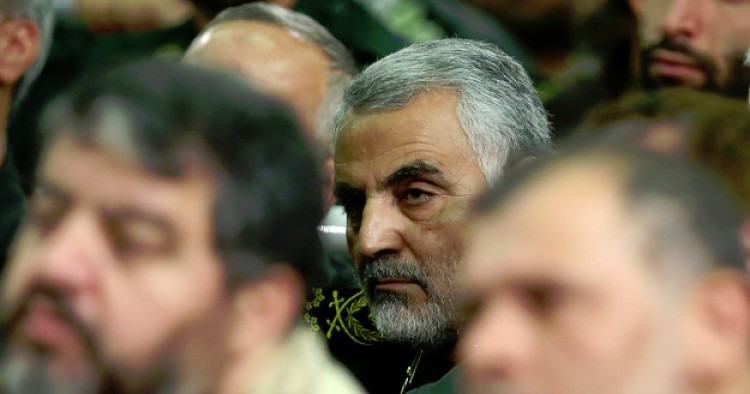Iran’s top general responsible for external operations marked the 10th assassination anniversary of late Hezbollah commander Imad Mughniyeh by promising the destruction of the state of Israel, the Iranian media reported. “Avenging the blood of Imad and people like him who have been martyred in Palestine, Lebanon and Iran under the instructions of the Zionist regime [Israel] is through annihilation of this child-murdering Zionist regime. The enemy understands this is certain to happen,” Major General Qassem Soleimani, the chief commander of Iran’s elite Quds Force, said at a gathering in Tehran. He emphasized that just launching missiles at Israel is not sufficient. “This regime will not survive,” he added, referring to Israel. “This regime’s actions demonstrate its lack of durability as we see they’re scared and restless.” Soleimani, who oversees the policies and actions of the Islamic Revolution Guards Corps (IRGC) in the region and throughout the world, further stressed that the Gaza Strip and Lebanon have become “a permanent point of tension” for Israel and pledged that the Iranian-led “resistance front will expand” in the future. He also credited the growth of the “axis of resistance” to early efforts by Mughniyeh and other Iranian and Lebanese leaders. “Imad Mughniyeh’s fingerprint can be seen in each missile launched from Palestine [against Israel],” he said.
Comment: Iranian leaders often call for the destruction of Israel. But the timing of Soleimani’s remarks is significant as his threat came just days after dangerous cross-border clashes between Israeli and Iranian-led forces in Syria.
Last weekend, the Israeli military conducted air strikes reportedly destroying the command-and-control center of the Iranian-led drone operation headquarter near Syria’s Palmyra. Israel says the strikes were a response to an Iranian drone that had entered its territory, but Tehran denied it. After the bombardment, one of Israeli F-16 fighter jets was shot down by a Syrian surface-to-air missile. Israel responded to the incident by carrying out more extensive air strikes against Syrian and Iranian military targets inside Syria.
The clashes prompted concerns about the danger of direct conflict between Iran and Israel.
Iran and its regional proxies have made it clear that they will maintain a long-term presence in southern Syria. Iran’s militia allies have also indicated that they will use southern Syria as a second front against Israel in any potential war between Israel and Hezbollah in the future.
In March, Harakat al-Nujaba, an Iraqi militia group sponsored by Iran, announced the creation of a new brigade to seize the Golan Heights – claiming that “latest victories” against the Islamic State and Sunni rebels in Iraq and Syria have allowed the group and its allies to focus on Israel. Leaders of the group claimed that members of the new brigade are highly-trained, well-equipped and capable of fighting the Jewish state. “Israel is weaker than a spider web. Islamic resistance is capable of confronting the axis of evil and annihilating the occupying Zionist regime,” Akram al-Kaabi, the leader of the group, told Lebanon-based Arabic-language al-Mayadeen news network.
In his latest trip to Lebanon this week, Kaabi renewed his warning to Israel after visiting Mughniyeh’s tomb in southern Beirut. “We, at the axis of resistance, will mobilize forces against Israel at any place. And until all threats are removed, the Zionist regime [Israel] is destroyed and the sacred Quds [Jerusalem] is completely liberated, we will not take a break and will fight alongside the Syrian Army and the resistance fighters in all battles against the aggressors.”
Mughniyeh, a senior Hezbollah commander, was killed in a bomb explosion in the Syrian capital in February, 2008. Tehran and Hezbollah say Israel was behind the attack.
The Middle East Institute (MEI) is an independent, non-partisan, non-for-profit, educational organization. It does not engage in advocacy and its scholars’ opinions are their own. MEI welcomes financial donations, but retains sole editorial control over its work and its publications reflect only the authors’ views. For a listing of MEI donors, please click here.













